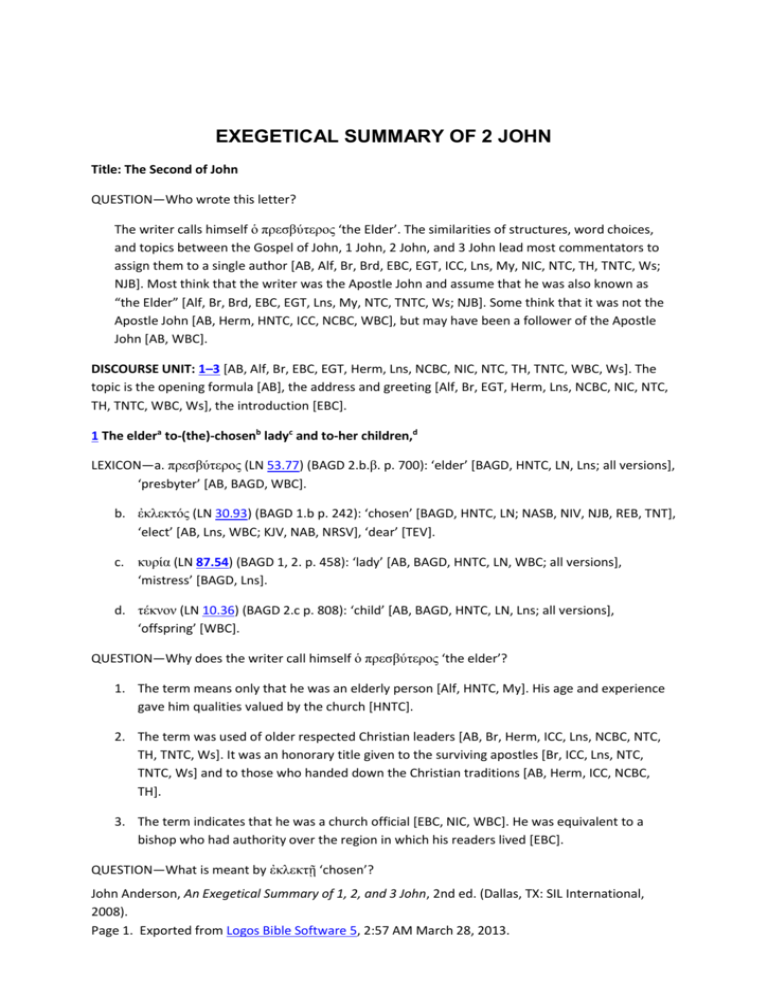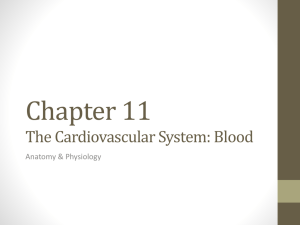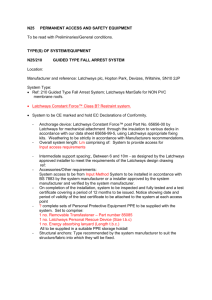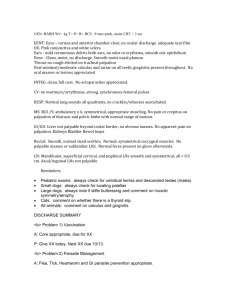5824.EXEGETICAL SUMMARY OF 2 JOHN v 1-6
advertisement

EXEGETICAL SUMMARY OF 2 JOHN Title: The Second of John QUESTION—Who wrote this letter? The writer calls himself ὁ πρεσβύτερος ‘the Elder’. The similarities of structures, word choices, and topics between the Gospel of John, 1 John, 2 John, and 3 John lead most commentators to assign them to a single author [AB, Alf, Br, Brd, EBC, EGT, ICC, Lns, My, NIC, NTC, TH, TNTC, Ws; NJB]. Most think that the writer was the Apostle John and assume that he was also known as “the Elder” [Alf, Br, Brd, EBC, EGT, Lns, My, NTC, TNTC, Ws; NJB]. Some think that it was not the Apostle John [AB, Herm, HNTC, ICC, NCBC, WBC], but may have been a follower of the Apostle John [AB, WBC]. DISCOURSE UNIT: 1–3 [AB, Alf, Br, EBC, EGT, Herm, Lns, NCBC, NIC, NTC, TH, TNTC, WBC, Ws]. The topic is the opening formula [AB], the address and greeting [Alf, Br, EGT, Herm, Lns, NCBC, NIC, NTC, TH, TNTC, WBC, Ws], the introduction [EBC]. 1 The eldera to-(the)-chosenb ladyc and to-her children,d LEXICON—a. πρεσβύτερος (LN 53.77) (BAGD 2.b.β. p. 700): ‘elder’ [BAGD, HNTC, LN, Lns; all versions], ‘presbyter’ [AB, BAGD, WBC]. b. ἐκλεκτός (LN 30.93) (BAGD 1.b p. 242): ‘chosen’ [BAGD, HNTC, LN; NASB, NIV, NJB, REB, TNT], ‘elect’ [AB, Lns, WBC; KJV, NAB, NRSV], ‘dear’ [TEV]. c. κυρία (LN 87.54) (BAGD 1, 2. p. 458): ‘lady’ [AB, BAGD, HNTC, LN, WBC; all versions], ‘mistress’ [BAGD, Lns]. d. τέκνον (LN 10.36) (BAGD 2.c p. 808): ‘child’ [AB, BAGD, HNTC, LN, Lns; all versions], ‘offspring’ [WBC]. QUESTION—Why does the writer call himself ὁ πρεσβύτερος ‘the elder’? 1. The term means only that he was an elderly person [Alf, HNTC, My]. His age and experience gave him qualities valued by the church [HNTC]. 2. The term was used of older respected Christian leaders [AB, Br, Herm, ICC, Lns, NCBC, NTC, TH, TNTC, Ws]. It was an honorary title given to the surviving apostles [Br, ICC, Lns, NTC, TNTC, Ws] and to those who handed down the Christian traditions [AB, Herm, ICC, NCBC, TH]. 3. The term indicates that he was a church official [EBC, NIC, WBC]. He was equivalent to a bishop who had authority over the region in which his readers lived [EBC]. QUESTION—What is meant by ἐκλεκτῇ ‘chosen’? John Anderson, An Exegetical Summary of 1, 2, and 3 John, 2nd ed. (Dallas, TX: SIL International, 2008). Page 1. Exported from Logos Bible Software 5, 2:57 AM March 28, 2013. It means that God chose the lady to belong to himself [BAGD, HNTC, Lns, NIC, WBC; REB, TNT] and to give her salvation [TH]. It was a standard designation for Christians [TH]. QUESTION—To whom does κυρίᾳ ‘lady’ refer, and to whom does τέκνοις αὐτῆς’ ‘her children’ refer? 1. ‘Lady’ is a metaphorical reference to a church, and the individual members of that congregation are called her ‘children’ [AB, BAGD, Br, Herm, HNTC, ICC, Lns, My, NCBC, NIC, NTC, TH, TNTC, WBC, Ws; NJB, TEV]. One commentator thinks that instead of one particular church, the letter was to be passed from church to church, each of which in turn would be the lady [Herm]. The children need not be all males [Alf], the designation ‘children’ includes daughters [My]. 2. It refers to an individual lady and her children [Alf, Brd, EGT]. 2.1 Her name is not mentioned [Brd]: to the elect lady. 2.2 The lady’s name is κυρία [Alf, EGT]: to the elect Kyria. whom I lovea inb truth,c LEXICON—a. pres. act. indic. of ἀγαπάω (LN 25.43): ‘to love’ [AB, HNTC, LN, Lns, WBC; all versions]. See this word at 1 John 2:10; 3:10, 11, 14, 18, 23; 4:7, 8, 10, 11, 12, 19, 20, 21; 5:1, 2; 3 John 1. b. ἐν with dative object (LN 70.4): ‘in’ [AB, HNTC, WBC; all versions except TEV], ‘in connection with’ [Lns], ‘within the fellowship of’ [TNT]. c. ἀλήθεια (LN 70.4) (BAGD 3. p. 36): ‘truth’ [AB, HNTC, Lns, WBC; all versions except TEV]. The phrase ἐν ἀληθείᾳ ‘in truth’ is translated as an adverb modifying ‘I love’: ‘truly’ [BAGD; TEV], ‘really’ [LN]. QUESTION—To whom does οὕς ‘whom (masculine plural)’ refer? It refers to both the lady and her children [AB, Alf, Br, Brd, EGT, My, TH, TNTC, Ws]. QUESTION—What relationship is indicated by the preposition phrase ἐν ἀληθείᾳ ‘in truth’? 1. It refers to the truth of the gospel [AB, Alf, Br, Brd, EBC, EGT, Herm, HNTC, ICC, Lns, NCBC, NIC, TNTC, WBC]: whom I love in connection with the truth. He loves them as fellow believers, all believing the truth [Br]. Love is based on fellowship in Christian knowledge and faith [EGT]. Love is regulated by the truth [ICC]. He loves in a way that is consistent with Christian revelation [AB, NIC]. Truth abiding in the writer brings about such Christian love [Alf]. 2. It is adverbial, indicating the manner in which he loves [BAGD, ICC, LN, My, TH, Ws; TEV]: whom I truly love. and not I onlya butb also all the-(ones) having-knownc the truth,d John Anderson, An Exegetical Summary of 1, 2, and 3 John, 2nd ed. (Dallas, TX: SIL International, 2008). Page 2. Exported from Logos Bible Software 5, 2:57 AM March 28, 2013. LEXICON—a. μόνος (LN 58.51) (BAGD 1.a.γ. p. 527): ‘only’ [AB, BAGD; all versions except REB], ‘alone’ [BAGD, HNTC, LN, Lns, WBC; REB]. b. ἀλλά (LN 89.125): ‘but’ [AB, HNTC, Lns, WBC; all versions except NJB], ‘for so’ [NJB]. c. perf. act. participle of γινώσκω (LN 32.16) (BAGD 6.a.α p. 161): ‘to know’ [BAGD, HNTC, Lns, WBC; KJV, NASB, NIV, NRSV, REB, TEV], ‘to come to know’ [AB, BAGD; NAB, NJB, TNT], ‘to come to understand’ [LN]. The perfect tense indicates that the knowledge was acquired in the past and is now a present possession [Brd, Lns, NIC, WBC]. The focus is on the present knowledge [NTC]. d. ἀλήθεια (LN 72.2) (BAGD 2.b. p. 36): ‘truth’ [AB, BAGD, HNTC, LN, Lns, WBC; all versions]. QUESTION—What is meant by πάντες οἱ ἐγνωκότες τὴν ἀλήθειαν ‘all who know the truth’? ‘The truth’ refers to the truth of the gospel [BAGD, Brd, ICC, Lns, My, NIC, TH, TNTC, WBC, Ws] and to know the truth includes accepting it and being committed to it [NIC]. Those who know the truth are all Christians [AB, Alf, Br, EBC, EGT, Herm, HNTC, ICC, Lns, My, NCBC, NTC, WBC]. There is an implied contrast with the false teachers who do not know the truth [EBC, HNTC, ICC, My, NTC, TH, TNTC, WBC]. 2 because-ofa the truthb remainingc ind us, LEXICON—a. διά with accusative object (LN 89.26): ‘because of’ [NIV, NJB, NRSV, TNT], ‘because’ [TEV], ‘on account of’ [HNTC, WBC], ‘for the sake of’ [Lns; KJV, NASB, REB], ‘based on’ [AB; NAB]. b. ἀλήθεια (LN 72.2): ‘truth’ [AB, HNTC, Lns, WBC; all versions]. See this word at v. 1. c. pres. act. participle of μένω (LN 68.11): ‘to remain’ [LN, Lns, WBC; NJB, TEV], ‘to abide’ [AB; NAB, NASB, NRSV], ‘to dwell’ [HNTC; KJV, REB], ‘to live’ [NIV], ‘to be’ [TNT]. See this word at 1 John 2:14. d. ἐν with dative object (LN 89.119): ‘in’ [AB, HNTC, Lns, WBC; all versions except REB], ‘among’ [REB]. See this word at 1 John 2:14. QUESTION—What relationship is indicated by διά ‘because of’? It indicates the reason that the writer and all those who know the truth love the elect lady and her children [Alf, Brd, EBC, Herm, ICC, Lns, NIC, TH, TNTC, WBC, Ws]: we love all of you because of the truth that remains in us. The truth creates an inner compulsion to love [NIC, WBC]. They love each other because of the truth they share [TNTC, Ws]. Some consider this clause to be directly related to ‘I love’, and the clause ‘and not only I, but also all who know the truth’ is parenthetical [Brd, TH, WBC; NIV]. Others connect it directly to the clause ‘all who know the truth’ to show how the truth is the motivation for love [Alf, EBC]. One commentator refers to two relationships: all who know the truth know it because the truth abides in all Christians and that abiding truth causes them to love the lady and her children [AB]. John Anderson, An Exegetical Summary of 1, 2, and 3 John, 2nd ed. (Dallas, TX: SIL International, 2008). Page 3. Exported from Logos Bible Software 5, 2:57 AM March 28, 2013. QUESTION—What is meant by τὴν ἀλήθειαν ‘the truth’? It means the Christian truth as in the preceding clause [AB, Brd, EBC, Herm, Lns]. QUESTION—To whom does ἡμῶν ‘us’ refer? It is inclusive and refers to the writer together with those to whom he writes [Alf, ICC, Lns, My, NIC, TH, TNTC, WBC, Ws]. and will-be witha us to the age.b LEXICON—a. μετά with genitive object (LN 89.108): ‘with’ [AB, HNTC, Lns; all versions], not explicit [WBC]. b. αἰών (LN 67.95) (BAGD 1.b. p. 27): ‘age’. The phrase εἰς τὸν αἰῶνα ‘to the age’ is translated ‘forever’ [AB, HNTC, Lns, WBC; all versions], ‘to eternity’ [BAGD]. QUESTION—What is the significance of the change from ἐν ‘in’ to μετά ‘with’? Some commentators think there is no semantic difference intended [TH, TNTC, WBC]. Others make distinctions. The truth remains in our hearts and will be with us as a companion [Lns]. ‘With’ emphasizes the objectivity of the truth [My]. 3 Gracea mercyb peacec will-bed withe us TEXT—Instead of ἡμῶν ‘us’, some manuscripts have ὑμῶν ‘you’. GNT has ἡμῶν ‘us’ and does not mention the other reading. Only KJV follows the reading ὑμῶν ‘you’. LEXICON—a. χάρις (LN 88.66) (BAGD 2.c. p. 877): ‘grace’ [AB, BAGD, HNTC, LN, Lns, WBC; all versions], ‘favor’ [BAGD], ‘kindness’ [LN]. b. ἔλεος (LN 88.76) (BAGD 2.a. p. 250): ‘mercy’ [AB, BAGD, HNTC, LN, Lns, WBC; all versions except NJB], ‘faithful love’ [NJB]. c. εἰρήνη (LN 22.42) (BAGD 2. p. 227): ‘peace’ [AB, HNTC, LN, Lns, WBC; all versions], ‘health’ [BAGD]. d. fut. mid. (deponent = act.) indic. of εἰμί (LN 13.1): ‘to be’ [AB, HNTC, Lns, WBC; all versions except NAB, NJB], ‘to have’ [NAB, NJB]. e. μετά with genitive object (LN 90.60) (BAGD A.II.1.c.γ. p. 509): ‘with’ [AB, BAGD, HNTC, LN, Lns; all versions except NJB, TEV], not explicit [WBC; NJB, TEV]. QUESTION—What is meant by χάρις ‘grace’? It means undeserved favor [Alf, Brd, Lns, NCBC, NIC, TH, TNTC, WBC, Ws], desiring good for his people [WBC], and forgiveness of sin [NTC]. QUESTION—What is meant by ἔλεος ‘mercy’? John Anderson, An Exegetical Summary of 1, 2, and 3 John, 2nd ed. (Dallas, TX: SIL International, 2008). Page 4. Exported from Logos Bible Software 5, 2:57 AM March 28, 2013. It means compassion in alleviating suffering [Alf, Brd, Lns, NCBC, NTC, TH, TNTC, Ws], and forgiveness of sin [NIC, WBC]. It is much the same as grace [NIC]. QUESTION—What is meant by εἰρήνη ‘peace’? It means well-being [Brd, Lns, NCBC, TH, WBC] both in health [Alf, Herm] and spiritually [Brd, WBC]. It is a good relationship between God and man [Alf, HNTC, NIC, NTC, TH, TNTC, Ws]. QUESTION—What does the use of the future tense of the verb εἰμί ‘to be’ indicate? 1. The future tense makes a statement of expectation or promise [AB, Brd, EBC, EGT, ICC, Lns, NIC, NTC, TH, TNTC, WBC, Ws; NAB, NJB, REB, TNT]: we will have grace, mercy, and peace. It is a positive assertion rather than a wish [NIC, TNTC]. The recipients of the letter were in need of such assurance [WBC]. 2. This is a wish or prayer [Alf, Herm, My; KJV, TEV]: may we have grace, mercy, and peace. The future tense indicates confidence that this will happen [Alf, My]. QUESTION—To whom does ἡμῶν ‘us’ refer? It is we inclusive and refers to both the writer and those to whom the letter is being sent [Ws]. froma God (the) Father, and from Jesus Christ the Son of-the Father, TEXT—Before ‘Ιησοῦ Χριστοῦ ‘Jesus Christ’, some manuscripts include κυρίου ‘Lord’. It is omitted by GNT with a B rating, indicating some degree of doubt. The reading κυρίου ‘Lord’ is included only by KJV. LEXICON—a. παρά with genitive object (LN 90.14) (BAGD I.3.b. p. 610): ‘from’ [AB, BAGD, HNTC, LN, Lns, WBC; all versions except TEV], not explicit [TEV]. QUESTION—What is the significance of repeating the preposition παρά ‘from’ with both ‘the Father’ and ‘his Son’? It indicates that the Father and Son are being treated as equals [Lns, My, NCBC, NIC, NTC, TNTC, Ws]. QUESTION—What is the significance of the phrase τοῦ υἱοῦ τοῦ πατρός ‘the Son of the Father’? It emphasizes Christ’s close union with the Father [Alf, Brd, TNTC, WBC, Ws]. The emphasis on Jesus’ identity as the Son of God counteracts the heresy of that time [Brd, Lns]. ina truthb and love.c LEXICON—a. ἐν with dative object (LN 89.26; 89.80): ‘in’ [AB, HNTC, WBC; all versions], ‘in connection with’ [Lns]. b. ἀλήθεια (LN 72.2): ‘truth’ [AB, HNTC, LN, Lns, WBC; all versions]. John Anderson, An Exegetical Summary of 1, 2, and 3 John, 2nd ed. (Dallas, TX: SIL International, 2008). Page 5. Exported from Logos Bible Software 5, 2:57 AM March 28, 2013. c. ἀγάπη (LN 25.43): ‘love’ [AB, HNTC, LN, Lns, WBC; all versions]. See this word at 1 John 2:5, 15; 3:1, 16, 17; 4:7, 8, 9, 10, 12, 16, 17, 18; 5:3. QUESTION—What relationship is indicated by the preposition ἐν ‘in’? Commentators find the relationship puzzling [AB, HNTC, NIC, TH, TNTC, WBC]. TNTC suggests that truth and love may be conditions, consequences, or accompaniments of receiving grace, mercy, and peace. TH suggests that truth and love may qualify how the blessings work in the people or they may indicate how God and Jesus Christ give the blessings. Truth and love in the life of the believer may be the conditions for receiving grace, mercy, and peace [Alf, EBC, NIC, NTC; NAB, NJB]. We must remain in God’s truth and love to receive his blessings [EBC]. QUESTION—What is meant by ἀληθείᾳ ‘truth’? It means the truth of the gospel [Brd, ICC, TH]. DISCOURSE UNIT: 4–12 [AB]. The topic is the body of letter. DISCOURSE UNIT: 4–11 [Alf, EBC, ICC, Lns, NTC, TH, TNTC, WBC, Ws; TEV]. The topic is truth and love [Alf, TH; TEV], exhortation and warning [EBC, ICC, Lns, NTC, Ws], instructions [NTC], the body of letter [Lns, TNTC, WBC]. DISCOURSE UNIT: 4–7 [NCBC]. The topic is a warning against false teachers. DISCOURSE UNIT: 4–6 [EBC, Herm, NIC, NTC; NJB, TEV]. The topic is exhortation [EBC, Herm, NTC], truth and love [NIC; NJB, TEV]. DISCOURSE UNIT: 4 [Br, Brd]. The topic is the occasion for rejoicing [Br, Brd]. 4 I-rejoiceda very-muchb because/thatc I-have-foundd (some) of your children walkinge inf truth,g LEXICON—a. aorist pass. (deponent = act.) indic. of χαίρω (LN 25.125) (BAGD 1. p. 873): ‘to rejoice’ LN, [BAGD, Lns; KJV], ‘to be glad’ [BAGD, LN; NASB, REB], ‘to be happy’ [TEV, TNT], ‘to give joy’ [AB; NAB, NIV, NJB], ‘to be delighted’ [HNTC], ‘to be overjoyed’ [WBC; NRSV]. The passive voice is active in meaning [NTC]. b. λίαν (LN 78.1) (BAGD 1. p. 473): ‘very much’ [BAGD], ‘much’ [AB], ‘greatly’ [Lns; KJV], not explicit [HNTC, WBC; NRSV, TEV]. This adverb is also translated as an adjective: ‘great (joy)’ [NAB, NIV, NJB], ‘very (glad/happy)’ [NASB, REB, TNT]. c. ὅτι (LN 89.33): ‘because’ [Lns], ‘that’ [KJV, NJB, REB, TEV], not explicit [AB, HNTC, WBC; NAB, NASB, NIV, NRSV, TNT]. d. perf. act. indic. of εὑρίσκω (LN 27.1): ‘to find’ [AB, HNTC, LN, Lns, WBC; all versions]. e. pres. act. participle of περιπατέω (LN 41.11) (BAGD 2.a.δ. p. 649): ‘to walk’ [AB, BAGD, Lns; KJV, NASB, NIV, NRSV], ‘to live’ [BAGD, LN, WBC; REB, TEV, TNT]. The phrase περιπατοῦντας ἐν ‘walking in’ is translated ‘to walk in the way of’ [HNTC], ‘walking in the path of’ [NAB], ‘living the life of’ [NJB]. The present tense indicates a continuing activity [Brd, WBC]. John Anderson, An Exegetical Summary of 1, 2, and 3 John, 2nd ed. (Dallas, TX: SIL International, 2008). Page 6. Exported from Logos Bible Software 5, 2:57 AM March 28, 2013. f. ἐν with dative object (LN 70.4): ‘in’ [AB, WBC; all versions except NAB, NJB, REB], ‘by’ [REB], ‘in connection with’ [Lns]. For HNTC; NAB, NJB see above. g. ἀλήθεια (LN 72.2) (BAGD 2.b. p. 36): ‘truth’ [AB, BAGD, HNTC, LN, Lns, WBC; all versions]. QUESTION—What is indicated by the use of the aorist tense of the verb ἐχάρην ‘I rejoiced’? 1. The aorist tense refers to the specific time in the past when he received the information [Br, Brd, ICC, Lns, My, NTC, TH, WBC, Ws]. The rejoicing continues [Br, Ws]. 2. This is an epistolary aorist: he rejoices at the time of the writing, but it is past from the viewpoint of the recipients of the letter [Alf]. 3. This aorist tense is a convention used in letter writing with no reference to the past [AB]. QUESTION—How did the writer find out about the lady’s children? He had actually met some of her children in a place away from where the lady lived [Alf, Br, Brd, EGT, NIC, WBC, Ws] or news about them had been brought by traveling missionaries [EBC, ICC, Lns, NTC]. Another view is that he had visited the place where the lady and her children lived [My]. QUESTION—What is indicated by the use of the perfect tense εὕρηκα ‘I have found’? 1. The perfect tense indicates that the event of finding was in the past and the writer assumes that the situation continues [AB, NIC, NTC, WBC]. 2. The perfect tense indicates that the finding was repeated many times as various reports came in [Lns]. 3. The perfect tense here means virtually the same as the aorist tense [TH]. QUESTION—What is implied by the statement ‘some of her children’? 1. This implies that all the children he found were walking in the truth [AB, Alf, Br, Brd, EGT, NIC]. It does not imply that he had also found some of her children who were not walking in the truth [AB, Alf, Br, EGT]. He felt that what he found in them was true for the church in general [NIC]. 2. This implies that some of the children walked in the truth and the others did not [EBC, ICC, Lns, My, TH, WBC]. Probably news about the church was that false teachers had caused divisions and John was rejoicing that some had remained true to the faith [EBC]. Perhaps a majority of her children had been led astray [ICC], or perhaps only a minority [Lns]. QUESTION—What is meant by περιπατοῦντας ‘walking’? It means total life pattern [AB, BAGD, Brd, EGT, HNTC, NIC, TH, WBC, Ws; NAB, NJB, REB, TEV, TNT]. It involves both faith and practice [TNTC]. QUESTION—What is meant by ἀληθείᾳ ‘truth’ and how did they walk in it? John Anderson, An Exegetical Summary of 1, 2, and 3 John, 2nd ed. (Dallas, TX: SIL International, 2008). Page 7. Exported from Logos Bible Software 5, 2:57 AM March 28, 2013. 1. It means the Christian truth of the gospel [AB, Alf, BAGD, Brd, EGT, Lns, My, NIC, NTC, TH, TNTC, WBC]. They lived in accordance with the instruction found in the gospel [EGT, Lns, NIC, NTC, TH]. They both believed and obeyed God’s truth [TNTC, WBC]. They conducted their lives in the sphere of Christian truth [Brd]. Their way of life flowed from an internal principle of truth [AB]. 2. It means sincerely, properly [Herm, ICC, NCBC]. They lived in an authentic way [Herm]. There was perfection in every sphere of being [ICC]. asa a-commandmentb we-receivedc fromd the Father. LEXICON—a. καθώς (LN 64.14): ‘as’ [KJV, NJB, TNT], ‘just as’ [AB, HNTC, WBC; NAB, NASB, NIV, NRSV, TEV], ‘even as’ [Lns], ‘in accordance with’ [REB]. b. ἐντολή (LN 33.330): ‘commandment’ [AB, LN, Lns; KJV, NASB], ‘command’ [REB]. The phrase καθὼς ἐντολὴν ἐλάβομεν ‘as we received commandment’ is translated ‘as we were commanded’ [WBC; NAB, NJB, NRSV, TNT], ‘as (the Father) commanded us’ [HNTC; NIV, TEV]. See this word at 1 John 2:7. c. aorist act. indic. of λαμβάνω (LN 57.125) (BAGD 2. p. 465): ‘to receive’ [AB, BAGD, LN, Lns; KJV, NASB, REB], ‘to obtain’ [BAGD]. The aorist tense refers to a specific time in the past [TH, WBC], perhaps to the time Jesus spoke about it (John 13:34) [TH]. d. παρά with genitive object (LN 90.14) (BAGD I.3.b. p. 609): ‘from’ [AB, BAGD, Lns; KJV, NASB, REB], ‘by’ [WBC; NAB, NJB, NRSV, TNT], not explicit [HNTC; NIV, TEV]. QUESTION—To what does ἐντολήν ‘commandment’ refer? 1. It refers to the command to love one another (v. 5) [AB, Herm, HNTC, NCBC]. 2. It refers to the command to walk in the truth [Alf, Brd, My, TNTC]. This is general teaching of Scripture, not recorded in any specific verse [Brd]. 3. It refers to the command to love and to believe in the Son of God (1 John 3:23) [EBC, ICC, Lns, NIC, WBC]. QUESTION—Who is the implied subject of the verb ἐλάβομεν ‘we received’? It is ‘we inclusive’ and refers to the writer, those he is writing to, and all Christians [AB, Lns, TH, WBC]. DISCOURSE UNIT: 5–11 [Br, Brd]. The topic is exhortation and warning [Br, Brd]. 5 Anda nowb I-requestc you, lady, LEXICON—a. καί (LN 89.87): ‘and’ [HNTC, Lns, WBC; all versions except NAB], ‘but’ [AB; NAB]. b. νῦν (LN 67.38) (BAGD 2. p. 546): ‘now’ [AB, BAGD, HNTC, Lns, WBC; all versions except TEV]. John Anderson, An Exegetical Summary of 1, 2, and 3 John, 2nd ed. (Dallas, TX: SIL International, 2008). Page 8. Exported from Logos Bible Software 5, 2:57 AM March 28, 2013. c. pres. act. indic. of ἐρωτάω (LN 33.161) (BAGD 2. p. 312): ‘to request’ [BAGD, LN, Lns; NAB], ‘to make a request’ [AB; REB], ‘to ask’ [BAGD, HNTC, LN; NASB, NIV, NJB, NRSV, TEV], ‘to plead’ [WBC], ‘to beseech’ [KJV], not explicit [TNT]. QUESTION—What relationship is indicated by καὶ νῦν ‘and now’? This indicates that the writer is coming to the point of his letter [Alf, Brd, TH, WBC]. It introduces a specific way of walking in the truth (v. 4) [AB]. The ‘now’ may be temporal and contrast with the past rejoicing [AB, ICC, Lns, WBC], or it may be logical and give the result of rejoicing [My]. QUESTION—What is the significance of using the verb ἐρωτῶ ‘I request’? The word ἐρωτῶ ‘I request’ is the usual verb of request and has no connotation of begging [AB, ICC]. It indicates a polite command between equals [Lns, My, NTC, TNTC]. It indicates that he has authority and expects obedience [Alf, Brd]. not asa writingb you a-newc commandment,d LEXICON—a. ὡς (LN 64.12): ‘as’ [Lns; NASB], ‘as though’ [KJV, NJB, NRSV], ‘as if’ [AB, WBC; NAB], ‘by way of’ [HNTC], not explicit [NIV, REB, TEV, TNT]. b. pres. act. participle of γράφω (LN 33.61) (BAGD 4. p. 167): ‘to write’ [AB, BAGD, Lns, WBC; all versions except REB], ‘to send’ [REB], not explicit [HNTC]. See this word at 1 John 2:7. c. καινός (LN 28.33) (BAGD 2. p. 394): ‘new’ [AB, BAGD, HNTC, LN, Lns, WBC; all versions]. See this word at 1 John 2:7. d. ἐντολή (LN 33.330): ‘commandment’ [AB, HNTC, LN, Lns; all versions except TEV], ‘command’ [WBC; TEV]. See this word at 1 John 2:7. QUESTION—What relationship is indicated by the conjunction ὡς ‘as’? This does not mean that he is requesting rather than commanding. It means that his request involves a basic commandment, not something that he has devised [AB]. buta (that) which we-hadb fromc (the) beginning,d LEXICON—a. ἀλλά (LN 89.125): ‘but’ [HNTC, Lns; KJV, NASB, NIV, NRSV, TNT], ‘but only’ [NJB], ‘rather’ [AB; NAB], ‘but rather’ [WBC], not explicit [REB, TEV]. b. imperf. act. indic. of ἔχω (LN 90.65) (BAGD I.2.i. p. 333): ‘to have’ [AB, BAGD, HNTC, LN, Lns; all versions], ‘to have over one’ [BAGD], ‘to receive’ [WBC]. See this word at 1 John 2:7. c. ἀπό with genitive object (LN 67.131): ‘from’ [AB, HNTC, Lns, WBC; all versions]. d. ἀρχή (LN 67.65) (BAGD 1.b. p. 112): ‘beginning’ [AB, BAGD, HNTC, LN, Lns, WBC; all versions except NAB], ‘start’ [NAB]. See this word at 1 John 2:7. QUESTION—What is the implied subject of the verb εἴχομεν ‘we had’? John Anderson, An Exegetical Summary of 1, 2, and 3 John, 2nd ed. (Dallas, TX: SIL International, 2008). Page 9. Exported from Logos Bible Software 5, 2:57 AM March 28, 2013. It is ‘we inclusive’ and refers to the writer and those to whom he is writing [ICC, NCBC, WBC, Ws]. thata we-should-loveb one-another. LEXICON—a. ἵνα (LN 90.22): ‘that’ [Lns; all versions except NAB, TEV], not explicit [AB, HNTC, WBC; NAB, TEV]. b. pres. act. subj. of ἀγαπάω: ‘to love’. See this word at v. 1. QUESTION—What relationship is indicated by ὅτι ‘that’? 1. It indicates the content of the request [AB, My, NTC, TH, WBC, Ws]: I request that we should love one another. At the same time, it explains what the commandment is [AB, Ws]. Everything between is parenthetical [WBC, Ws]. 2. It explains the word ἐντολήν ‘command’ [ICC, Lns]: but a commandment we had from beginning, namely, the command that we should love one another. QUESTION—What is the implied subject of the verb ἀγαπῶμεν ‘we should love’? It is ‘we inclusive’ and refers to both the writer and those to whom he wrote [ICC, Lns, WBC, Ws]. 6 Anda this is love,b thatc we-should-walkd according-toe his commandments;f LEXICON—a. καί (LN 89.87): ‘and’ [Lns; KJV, NASB, NIV, NRSV], ‘now’ [AB], not explicit [HNTC, WBC; NAB, NJB, REB, TEV, TNT]. b. ἀγάπη: ‘love’. See this word at v. 3. c. ἵνα (LN 90.22) (BAGD II.1.e. p. 378): ‘that’ [AB, BAGD, Lns, WBC; all versions except NAB, NJB, REB], not explicit [HNTC; NAB, NJB, REB]. d. pres. act. subj. of περιπατέω: ‘to walk’. See this word at v. 4. e. κατά with accusative object (LN 89.8): ‘according to’ [AB, HNTC, Lns, WBC; all versions except KJV, NIV], ‘in obedience to’ [NIV, TEV], ‘after’ [KJV]. f. ἐντολή (LN 33.330): ‘commandment’ [AB, HNTC, Lns, WBC; all versions]. See this word at v. 5. QUESTION—To what does αὕτη ‘this’ refer? It refers to the following clause ὅτι ‘that’ clause [AB, Alf, Brd, Herm, My, TH, WBC, Ws; NIV]: this is love, namely, that we should walk according to his commandments. QUESTION—Who is the implied goal of the event word ἀγάπη ‘love’? 1. It is love for each other [AB, ICC, Lns, My, NIC, NTC]. Love is expressed in ways that are in accord with God’s commandments [NIC]. The highest expression of love for Christian brothers is obedience to all of God’s commandments that concern relations between brothers [ICC, My]. John Anderson, An Exegetical Summary of 1, 2, and 3 John, 2nd ed. (Dallas, TX: SIL International, 2008). Page 10. Exported from Logos Bible Software 5, 2:57 AM March 28, 2013. 2. It is love for God [Brd, NCBC]. 3. It is love for both God and our fellowman [TH, TNTC, WBC]. QUESTION—To whom does αὐτοῦ ‘his’ refer? It refers to God [AB, Brd, EBC, ICC, Lns, My, NIC, NTC, WBC; REB, TEV]. this is the commandment, asa you(pl.)-have-heardb from the beginning,c thatd ine it you(pl.)-shouldwalk.f LEXICON—a. καθώς (LN 64.14): ‘as’ [AB, HNTC, WBC; KJV, NAB, NIV, TEV], ‘even as’ [Lns], ‘just as’ [NASB, NRSV], ‘which’ [NJB], not explicit [REB]. The phrase is translated ‘this is the same commandment you have heard’ [TNT]. b. aorist act. indic. of ἀκούω (LN 24.52): ‘to hear’ [AB, HNTC, LN, Lns, WBC; all versions except REB]. This is also translated ‘that was given you’ [REB]. c. ἀρχή: ‘beginning’. See this word at v. 5. d. ἵνα (LN 90.22) (BAGD II.1.e. p. 378): ‘that’ [BAGD, HNTC, Lns; KJV, NASB, NIV, TEV], not explicit [AB, WBC; NAB, NJB, NRSV, REB, TNT]. e. ἐν with dative object (LN 89.76): ‘in’ [AB, Lns; all versions except NJB, REB], not explicit [NJB, REB]. The phrase ἐν αὐτῇ ‘in it’ is translated ‘along the path it lays down’ [HNTC], ‘according to which’ [WBC]. f. pres. act. subj. of περιπατέω: ‘to walk’. See this word at v. 4. QUESTION—To what does αὕτη ‘this’ refer? 1. It refers to the following ἵνα ‘that’ clause [Alf, HNTC, My, WBC, Ws; KJV]: this is the commandment, namely, that you should walk in it. 2. It refers to the command to love one another (v. 5) [AB]: that is the commandment; as you heard from the beginning, so (ὅτι) you must walk in it. QUESTION—What is the significance of the change from plural ἐντολάς ‘commandments’ to singular ἐντολή ‘commandment’? The plural form refers to all of God’s commands, while the singular form refers to the command to love one another [Alf, Brd, NIC, NTC, WBC, Ws], a commandment that sums up all the others [Alf]. QUESTION—To what does αὐτῇ ‘it’ refer? 1. It refers to love [Alf, Br, Brd, EGT, My, NIC, NTC, TNTC, WBC, Ws; NIV, NJB, TEV, TNT]: that you should walk in love. John Anderson, An Exegetical Summary of 1, 2, and 3 John, 2nd ed. (Dallas, TX: SIL International, 2008). Page 11. Exported from Logos Bible Software 5, 2:57 AM March 28, 2013. 2. It refers to the commandment [AB, HNTC, ICC, Lns; NAB, REB]: that you should walk in the commandment. DISCOURSE UNIT: 7–13 [NJB]. The topic is the enemies of Christ. DISCOURSE UNIT: 7–11 [EBC, Herm, NIC, NTC; TEV]. The topic is a warning against false teachers [EBC, Herm, NIC, NTC; TEV]. John Anderson, An Exegetical Summary of 1, 2, and 3 John, 2nd ed. (Dallas, TX: SIL International, 2008). Page 12. Exported from Logos Bible Software 5, 2:57 AM March 28, 2013.






